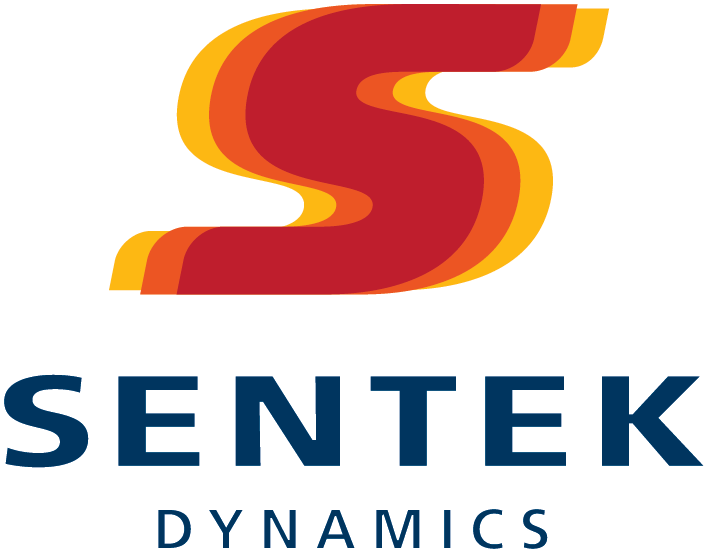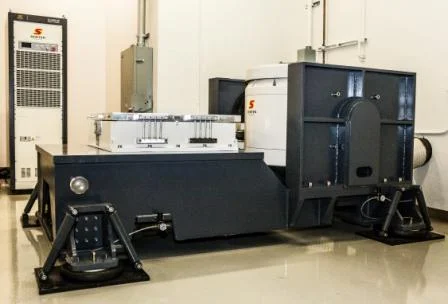To simulate equipment in a structure subject to earthquakes, vibration tests for seismic qualification utilizes different types of motion to effectively simulate the postulated seismic environment. Single frequency and multiple frequency are the two categories of motion that these types of motion fall into. Each category includes multiple waveform types for different cases.
Read moreGround Vibration Testing (GVT)
Ground Vibration Testing (GVT) includes the modal analysis of an aircraft and its sub-assembly components to analyze and detect any changes to their structural properties. The modal parameters determined through testing are then used to validate the analytical models. The modal characteristics are also used to predict the flutter of the aircraft in order to create a safe flight envelope before flight operation.
Read moreDual Shaker Sine Vibration Testing at Sentek Dynamics Lab in Charlotte, NC
Watch a dual shaker sine test performed on the Sentek Dynamics M5044A-PA155-LST900M Dual Shaker Vibration Testing System featuring Crystal Instruments Spider vibration controller.
Read moreMultiple Shaker Table Systems
There are many different shaker table arrangements based on various types of MIMO testing applications. The Multiple Shaker Table System ranges from Multiple Exciter Single Axis (MESA) to Multiple Exciter Multiple Axis (MEMA) with 2 to 6 shakers involved (e.g., three axis translational shaker table, four-poster, 6 DOF Multi Axis Shaker Table (MAST), etc.)
Read moreUsing Fatigue Damage Spectrum with Vibration Control
Fatigue Damage Spectrum (FDS) allows users to compare the potential damage caused by different Random profiles, Swept Sine profiles or a combination of both.
Read moreStructural measurements on infrastructure can ensure future safety and avert potential disasters.
Buildings, bridges, and dams are large stationary structures that are equally as important as vehicles and manufacturing equipment when it comes to understanding the dynamics of a structure. We may not immediately think of such large stationary structures or infrastructure as ever having any movement. However, when movement occurs for various reasons, including earthquakes or vehicles passing over a bridge, we find the consequences can be disastrous if structural engineers did not consider the structural dynamics of the structure upfront during the construction process.
Read moreMinimum Energy Option in MIMO Random
The Minimum Energy option of MIMO Random is implemented to handle the nonlinearity of a multi-shaker table and provide fast convergent control.
Read moreMIMO FRF Testing of License Plate
Extracting the natural frequencies, damping shapes, and mode shapes of a structure aids in improving the design of the unit under test. In this case, the modal characteristics of a license plate is acquired by performing a modal analysis.
A MIMO FRF test is carried out using a pair of modal shakers and 14 accelerometers to obtain the vibration characteristics. The shakers impart energy to the structure for a longer period, which ensures an increased data set. The higher quality of the measurements also aids in the better estimation of the modal parameters.
Read moreOperational Modal Analysis
Experimental modal analysis (EMA) is based on forced excitation tests during which Frequency Response Functions (FRFs) are measured. However, real world loading conditions often differ considerably from those used in lab testing. Since all real-world systems are to a certain extent non-linear, the models obtained under real loading will be linearized for much more representative working points. Additionally, environmental influences on system behavior, such as pre-stress of suspensions, load-induced stiffening or aero-elastic interaction, will be taken into account.
Read moreCenter of operation and monitoring of 12 or more shaker systems with API
Manufacturing plants often require controlled vibrations on various parts of the plant to run for several hours, days, or even weeks at a time. In some cases, continuous operation is required.
At these facilities, the affordable down time is limited to a few hours in a week. The continuous controlling and monitoring of independently running systems is another significant challenge. Monitoring each controller on a separate PC would require an unreasonable number of PCs to monitor. The necessity to run different types of controlled vibrations on these machines makes it impossible to use MIMO (Multi-Input Multi-Output) control. Also, when used with a single PC with MIMO control, memory and computational resources of the PC would become unreasonably high when the number of shakers needed to be controlled grows larger than 10.
Read more
